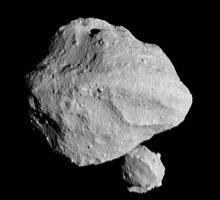NASA recently released this sequence of images captured by Hubble Space Telescope when the DART spacecraft rammed into the small asteroid Dimorphos, on September 26, 2022. In the top image, snapped just two hours after impact, "spikes" containing roughly 1,000 tons of dust radiate from the asteroid. In the second image, 17 hours after impact, the spikes have been sculpted by the gravity of the asteroid's larger companion, Didymos. And in the final panel, radiation from the Sun pushes material into twin tails that stretch thousands of miles from Dimorphos. Follow-up observations have confirmed that DART deflected the asteroid's orbit, suggesting that asteroids on course to slam into Earth might be deflected as well. [NASA/ESA/STScI/J. Li (PSI)]
You are here
Following Up
Astronomers continue to track an asteroid that took a big wallop a few months ago. The observations will tell us more about the asteroid. More important, they could help keep Earth safe from future threats.
Dimorphos is about 500 feet across. On September 26th, the DART spacecraft slammed into it at 14,000 miles per hour. The goal was to change how long it takes Dimorphos to orbit a larger asteroid, Didymos.
That’s important because many asteroids pass close to Earth. Some of them could someday threaten to hit us. One possible way to protect Earth is to ram something into the asteroid, altering its path just enough for it to safely pass us by.
DART was designed to test that technique. Scientists expected the impact to change Dimorphos’s orbit by about 10 minutes. As it turned out, the change was much bigger — about 32 minutes.
Part of the change was due to the impact itself. But the collision also blasted a huge amount of debris into space. That material acted as a jet, giving Dimorphos a big push. It also created a tail thousands of miles long.
Astronomers are studying that debris to learn about the asteroid. And late next year, Europe will send a craft to fly past Dimorphos. It’ll measure the size of the crater gouged by the impact. It’ll also look into the crater to determine the asteroid’s composition and structure — critical information in figuring out how effective DART’s impact really was.
Script by Damond Benningfield
Get Premium Audio
Listen to today's episode of StarDate on the web the same day it airs in high-quality streaming audio without any extra ads or announcements. Choose a $8 one-month pass, or listen every day for a year for just $30.






